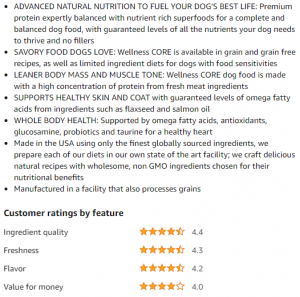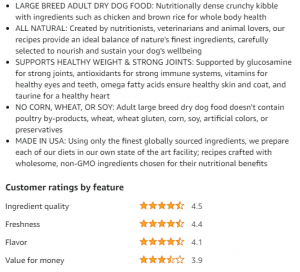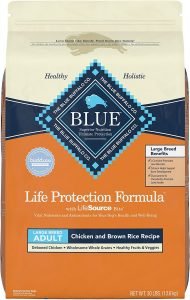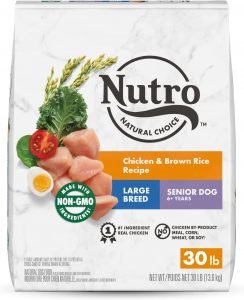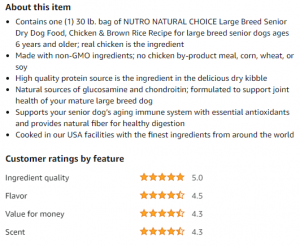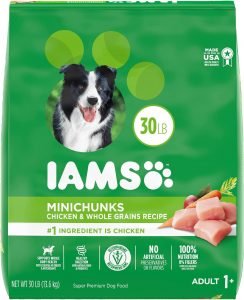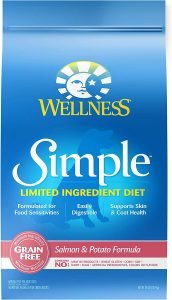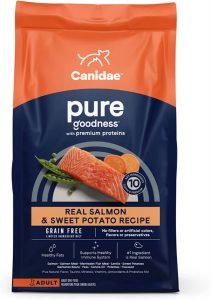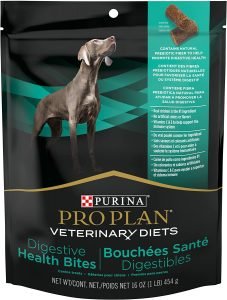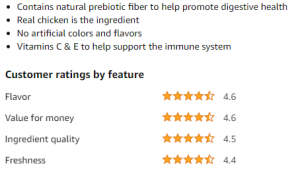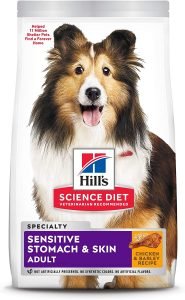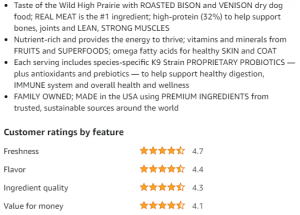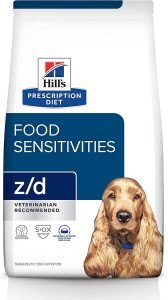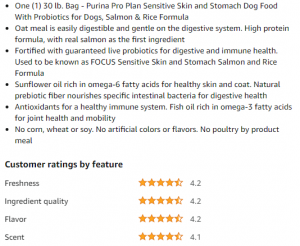
When it comes to choosing the best dog food, there’s a lot to think about. You need food that is complete and balanced, containing all the nutrients your dog needs to stay healthy.
You should pick a food that is appropriate for your dog’s age and activity level, as well as any special health needs your dog may have. With so many choices out there, you may be unsure where to start.
In this blog post, we’ll cover some of our favorite options for premium dog food that is good for your dog. We’ll also offer tips on how to choose the right food and what to look for on the label.
Choosing the Best Dog Food for Your Dog
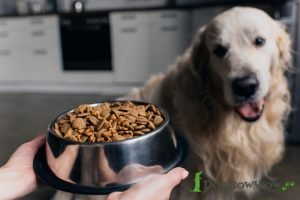
Finding the best dog food can be tricky, especially considering all the factors to factor in. It’s crucial that the ingredients are high quality and appropriate for your dog’s age, breed, and activity level.
The right dog food will contain all of the nutrients and calories your dog needs to stay healthy and fit.
You want to choose a food that is high in quality ingredients made with real meat, vegetables, and fruits, and avoiding foods made with fillers or by-products.
In addition, you should pick a food that fits your dog’s individual needs. If your dog is active, you may want to choose a food with added joint support or more calories. If your dog has sensitivities, you’ll want to choose a hypoallergenic formula.
Always read the ingredient list and nutrition facts panel on the food label to ensure that it meets your expectations.
Here are some things to look for when choosing the right food for your dog.
1. Protein: Dogs need protein to build and maintain muscle mass, as well as to support other bodily functions. Look for a food that contains at least 18% protein.
2. Fat: Fat is an important source of energy for dogs, and it also helps keep their skin and coat healthy. Choose a food with at least 5% fat.
3. Fiber: Fiber helps keep dogs regular and can help prevent some digestive problems. A good dog food will contain at least 3% fiber.
4. Moisture: Dogs need moisture to stay hydrated, and it’s especially important if they don’t drink a lot of water on their own. Choose a food that contains at least 10% moisture.
By following these tips, you’ll be able to find the right dog food for your dog.
Types of Dog Food

There are a variety of dog foods on the market, each with its own benefits and drawbacks. It’s important to choose the right food for your dog based on their individual needs.
1. Dry Dog Food
Dry dog food is a type of food that is specifically designed for dogs. It is typically made from a variety of different ingredients, including meat, grains, and vegetables. Dry dog food can be found in most pet stores and is often the preferred type of food for many dog owners.
The main benefit of dry dog food is that it is very easy to store and transport. Additionally, dry dog food generally contains more nutrients than other types of dog food, making it an ideal choice for those who are looking to provide their dogs with a healthy diet.
2. Canned Dog Food
Canned dog food is a popular option for dog owners because it is generally less expensive than dry food and easier to store. However, there are some things to keep in mind when feeding your dog canned food.
Canned dog food typically has a higher moisture content than dry food, which is important for dogs that don’t drink a lot of water. Dogs that eat canned food may also need to urinate more frequently.
Canned dog food can be a good option for dogs with certain health conditions, such as diabetes or kidney disease. Since canned food has more moisture, it can help prevent dehydration and make it easier for dogs to absorb nutrients.
If you choose to feed your dog canned food, be sure to select a high-quality brand that contains all the nutrients your dog needs. You should also talk to your veterinarian about how much canned food to feed your dog based on their individual needs.
3. Raw Dog Food
Raw dog food is a type of diet that consists of unprocessed, uncooked meats and organs. This type of diet is similar to what dogs would eat in the wild and is often seen as a more natural option for dog owners.
There are a variety of benefits associated with feeding your dog a raw diet, including improved digestion, healthier skin and coat, and increased energy levels.
Raw dog food can also be less expensive than commercial kibble diets, since you are not paying for the processing and cooking of the ingredients.
When switching your dog to a raw diet, it is important to do your research and speak with your veterinarian to ensure that you are providing a well-rounded and balanced meal plan.
4. Dehydrated Dog Food
Dehydrated dog food is a great option for dog owners who are looking for a healthy and convenient way to feed their dogs.
Dehydration removes water from the food, which concentrates the nutrients and makes the food more shelf-stable. This type of food is also less processed than other options, and it retains more of the original flavor and nutrients.
Dehydrated dog food is made by slowly removing the water content from fresh ingredients using a low-heat process. This leaves behind most of the vitamins, minerals, and antioxidants that are found in fresh foods.
Dehydration also helps to preserve the natural flavors of the ingredients. As a result, dehydrated dog food typically has a higher nutrient density than other types of dog food.
One downside of dehydrated dog food is that it can be more expensive than other options. However, many pet parents feel that the health benefits and convenience are worth the extra cost.
If you’re interested in feeding your dog a dehydrated diet, be sure to talk to your veterinarian first to make sure it’s a good option for your pup.
5. Freeze-Dried Dog Food
If you’re looking for a nutritious and convenient option for your dog’s food, freeze-dried dog food is a great choice.
Freeze-dried dog food is made by taking fresh, raw ingredients and removing the water content through a special freezing and drying process. This leaves behind all the essential nutrients and vitamins that your dog needs for a healthy diet.
One of the biggest advantages of freeze-dried dog food is that it’s extremely easy to store and transport. Since all the water has been removed, the food takes up very little space and doesn’t require any refrigeration. This makes it ideal for travel or if you have limited storage space in your home.
Another big benefit of freeze-dried dog food is that it’s highly digestible for dogs. This is because the freezing and drying process breaks down many of the complex carbohydrates and proteins into smaller molecules, making them easier for your dog to absorb and digest.
As a result, freeze-dried dog food can be especially helpful for dogs with gastrointestinal issues or sensitivities.
Food for Different Breeds
There are some factors to consider when you select the right food for your adult dog. One important factor is the breed of your dog. Different breeds have different nutritional needs, so it’s important to choose a food that is formulated specifically for your dog’s breed.
For example, small breeds generally need a higher calorie diet than large breeds. This is because small dogs have a higher metabolism and burn more calories than larger dogs. Small breeds also tend to have sensitive stomachs, so it’s important to choose a food that is easy on their digestive system.
On the other hand, large breeds tend to need foods that are lower in calories and fat. This is because they are more prone to obesity and joint problems. Large breeds also need foods that are high in protein and fiber to help them maintain a healthy weight.
So, depending on the breed of your dog, you will want to choose a food that meets their specific nutritional needs.
Dog Food for Small Breed Dogs
If you have a small breed dog, it’s important to choose the right food to keep them healthy and fit.
Small breed dogs have different nutritional needs than large breed dogs, so it’s important to find a food that is specifically tailored to their needs.
There are a lot of different brands and types of dog food on the market, so it can be tricky to know which one to choose. However, if you take the time to do your research, you can find the perfect food for your small breed dog.
When choosing a food for your small breed dog, look for something that is high in protein and low in calories.
Small breeds tend to be very active, so they need a lot of energy to keep up with their larger counterparts. A high-protein diet will help them maintain their energy levels and stay lean and muscular.
Additionally, look for a food that is rich in omega-3 fatty acids. These nutrients are essential for maintaining a healthy coat and skin, and they can also help reduce inflammation throughout the body.
Omega-3s are especially important for small breeds because they are prone to joint problems later in life.
Also make sure the food you choose is made with high-quality ingredients. Avoid foods that contain fillers or artificial additives, as these can be harmful to your dog’s health. Stick with natural, whole ingredients that will provide your dog with all the nutrients they need to stay healthy and happy.
Top Best Dog Foods for Small Breed Dogs
1. Merrick Lil Plates Small Breed Dry Dog Food with Real Meat
This grain-free dry food from Merrick is perfect for small breeds. It is packed with high-quality protein and fat from real chicken and turkey, plus it has added glucosamine and chondroitin for joint health. It also has limited ingredients and is easily digestible, making it perfect for small breeds with sensitive stomachs.
2. Wellness CORE Grain-Free High-Protein Dry Dog Food, Natural Ingredients
This grain-free dry food from Wellness CORE is another great option for small breeds. It contains high levels of protein and fat from real chicken and turkey, plus it has added glucosamine and chondroitin for joint support. It is also free of artificial ingredients, fillers, and preservatives, making it a great choice for small breeds with sensitive stomachs.
3. Nutro Ultra Small & Toy Breed Adult Dry
This grain-free dry food from Nutro is another excellent option for small breeds. It contains high levels of protein and fat from real chicken, turkey, and lamb, plus it has added glucosamine and chondroitin for joint support. It is also free of artificial ingredients, fillers, and preservatives, making it safe for small breeds with sensitive stomachs.
4. Taste of the Wild High Protein Premium Dry Dog Food
This grain-free dry food from Taste of the Wild is another great option for small breeds. It contains high levels of protein and fat from real venison and bison, plus it has added glucosamine and chondroitin for joint support. It is also free of artificial ingredients, fillers, and preservatives, making it a safe choice for small breeds with sensitive stomachs.
5. Zignature Limited Ingredient Formula Grain-Free
This grain-free dry food from Zignature is another excellent option for small breeds. It contains high levels of protein and fat from real chicken and turkey, plus it has added glucosamine and chondroitin for joint support. It is also free of artificial ingredients, fillers, and preservatives, making it safe for small breeds with sensitive stomachs.
These are just a few of our favorite dog foods for small breeds. If you are looking for more options, be sure to check out the full list of the best dog foods for small breed dogs.
Dog Food for Large Breed Dogs
If you have a large breed dog, there are some special considerations you’ll need to take into account, as large breed dogs have different nutritional needs than small breed dogs.
Fortified With Vitamins and Minerals
All dogs need vitamins and minerals, but large breed dogs tend to have different nutritional needs than smaller dogs. Look for a food that is fortified with these nutrients to keep your dog healthy and strong.
Low in Fat
Too much fat can lead to joint problems in large breed dogs. Because large breed dogs are more prone to joint problems, it’s important to find a food that will help keep their joints healthy. Choose a food that is lower in fat to help prevent these issues
Many large breed dog foods contain added glucosamine and chondroitin, which are two ingredients that have been shown to be helpful in supporting joint health.
High Vitamins and Minerals
You’ll want to choose a food that is easy on their stomachs and doesn’t cause them any digestive issues. You should pick a food that is packed with vitamins and minerals to keep them healthy and strong.
High in Calories and Protein
Another thing to consider when choosing a large breed dog food is the calorie content. Because large breed dogs are often quite active, they tend to need more calories than smaller dogs.
However, if you don’t want to choose a food that’s too high in calories, as this can lead to weight gain, you may opt to look for a food that has a moderate calorie content and provides plenty of energy for your dog’s activities.
Top 5 Dog Foods for Large Breed Dogs
1. Wellness Complete Health Large Breed Formula
2. Blue Buffalo Life Protection Formula Large Breed Chicken & Brown Rice Recipe
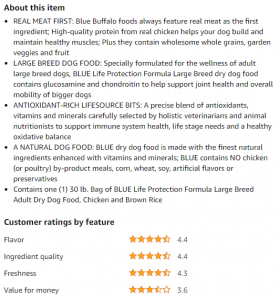
3. Nutro Max Large Breed Puppy Formula
4. Purina ONE SmartBlend Large Breed Formula
5. Iams ProActive Health Large Breed Formula
Dog Food for Senior Dogs
As your dog begins to age, their nutritional needs change. They need food that is easier to digest and that contains nutrients that support cognitive health and joint function. Here are a few things to look for when choosing dog food for your senior dog.
1. Easier to Digest
As dogs age, their digestive system becomes less efficient at breaking down and absorbing nutrients. Look for dog food that is specifically formulated for seniors and contains easily digestible ingredients like chicken, rice, and vegetables.
2. Nutrients for Cognitive Health
Senior dogs are more susceptible to cognitive decline, so it’s important to choose a food that contains brain-supporting nutrients like omega-3 fatty acids and antioxidants.
3. Joint Support
Arthritis is common in senior dogs, so look for a food that contains joint-supporting ingredients like glucosamine and chondroitin sulfate.
4. Calories
As your dog’s metabolism slows down with age, they will require fewer calories than when they were younger. Choose a food that has fewer calories per serving but still provides all the essential nutrients your senior dog needs.
5. Smaller Kibble Size
As dogs age, their teeth and gums can become less healthy. Smaller kibble sizes are easier on your senior dog’s teeth and gums and are less likely to cause them pain.
When choosing a dog food for your senior dog, it’s important to consult with your veterinarian to make sure you are selecting the best food for your individual dog’s needs.
How Often to Feed Your Adult Dog
Assuming you have a healthy, adult dog, how often you feed them is really up to you and your schedule.
If you’re home all day and want to keep your pup well-fed, then three meals a day is appropriate.
If you work long hours or are frequently away from home, then twice a day may be better. It’s really whatever works best for you and your pet.
Of course, there are some general guidelines when it comes to feeding an adult dog.
For example, most experts recommend that puppies under six months old eat three to four times a day. After that, they can be transitioned to two meals per day.
Older dogs (seven years and up) may do better on one meal per day since they tend to have slower metabolisms and may have trouble digesting multiple meals.
How Much to Feed Your Dog
The amount of food you give your dog will depend on a number of factors, including their age, activity level, and weight.
Puppies need more food than adult dogs, since they are growing and developing. You’ll also want to feed them more often – puppies can eat up to three times a day. Adult dogs only need to be fed once or twice a day.
The type of food you feed your dog will also affect how much you need to give them. Dry food is usually more concentrated than wet food, so you’ll need to give your dog less of it. Make sure to read the labels on your dog’s food to figure out how much they should be eating each day.
If your dog is very active, they may need more food than a less active dog. Working dogs and those who exercise frequently will need more calories to maintain their energy levels.
Finally, the size of your dog will also affect how much food they need.
A large breed dog will obviously eat more than a small breed dog.
But even within breeds, there can be variation in how much individual dogs eat. Pay attention to your dog’s appetite and body condition to make sure they’re getting the right amount of food each day.
Best Adult Dog Foods for Allergies
There are a few different types of food that are generally considered to be the best for dogs with allergies, and we will go over a few of them here.
One type of food that is often recommended for dogs with allergies is grain-free food.
This type of food does not contain any wheat, corn, or soy, which are all common allergens for dogs.
Grain-free food also tends to be higher in protein, which can be beneficial for dogs with allergies.
Another type of food that is often recommended for dogs with allergies is limited ingredient food.
This type of food contains fewer ingredients than most other types of dog food, which can make it easier to identify potential allergens.
Limited ingredient foods also tend to be grain-free and high in protein.
Finally, raw diets are sometimes recommended for dogs with allergies. Raw diets generally consist of meat, bones, organs, and vegetables.
These diets are often high in protein and fat and low in carbohydrates, which can be beneficial for dogs with allergies. Raw diets can also be customized to avoid specific allergens that your dog may be sensitive to.
The Best Dog Foods for Allergies
Here are the top 10 best dog foods for allergies according to real users.
1. Wellness Simple Limited Ingredient Diet
2. CANIDAE Pure Real Salmon & Sweet Potato Recipe
3. Taste of the Wild PREY High Protein
4. Purina Pro Plan Veterinary Diets HA Chicken Flavor
5. Merrick Grain Free Canned Wet Dog Food – Real Meat
6. Hill’s Science Diet Grain Free
7. Taste of the Wild High Protein
8. Hill’s Food Sensitivities Dry Dog Food
9. Natural Balance Limited Ingredient Diet
10. Purina Pro Plan Sensitive Skin & Stomach
Conclusion
There are a lot of factors to consider when choosing the right dog food for your pet. However, one of the most important considerations is whether or not your dog has any allergies. If they do, it’s crucial to find a food that doesn’t contain any ingredients that could trigger an allergic reaction. Luckily, there are plenty of great options out there for dogs with allergies. We hope this list has helped you narrow down the search for the best dog food for your furry friend.


